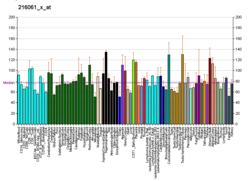PDGFB
Podjedinica B trombocitno-izvedenog faktora rasta jest protein koji je kod ljudi kodiran genom PDGFB sa hromosoma 22.[5][6]
Aminokiselinska sekvenca uredi
Dužina polipeptidnog lanca je 241 aminokiselina, a molekulska težina 27.283 Da.[6]
| 10 | 20 | 30 | 40 | 50 | ||||
|---|---|---|---|---|---|---|---|---|
| MNRCWALFLS | LCCYLRLVSA | EGDPIPEELY | EMLSDHSIRS | FDDLQRLLHG | ||||
| DPGEEDGAEL | DLNMTRSHSG | GELESLARGR | RSLGSLTIAE | PAMIAECKTR | ||||
| TEVFEISRRL | IDRTNANFLV | WPPCVEVQRC | SGCCNNRNVQ | CRPTQVQLRP | ||||
| VQVRKIEIVR | KKPIFKKATV | TLEDHLACKC | ETVAAARPVT | RSPGGSQEQR | ||||
| AKTPQTRVTI | RTVRVRRPPK | GKHRKFKHTH | DKTALKETLG | A |
Funkcija uredi
Protein kodiran ovim genom je član porodice trombocitnih faktora rasta. Četiri člana ove porodice su mitogeni faktori za ćelije mezenhimskog porijekla i karakteriše ih motiv od osam cisteina. Ovaj genski proizvod može postojati ili kao homodimer (PDGF-BB) ili kao heterodimer sa polipeptidnim faktorom rasta alfa (PDGFA) koji potiče od trombocita (PDGF-AB), gdje su dimeri povezani disulfidnim vezama.
Klinički značaj uredi
Mutacije ovog gena povezane su sa meningiomom. Recipročne translokacije između hromozoma 22 i 17, na mjestima gdje su locirani geni PDGFB i COL1A1 ili, alternativno, abnormalni mali prekobrojni prstenasti hromosom spajaju ova dva gena u formiraju COL1A-PDGFB fuzijski gen. Ovaj fuzijski gen u velikoj mjeri prekomjerno proizvodi PDGFB i smatra se odgovornim za izazivanje razvoja i/ili progresije tri blisko povezana fibroblastna i miofibroblastna tumora kože: fibroblastom divovskih ćelija, dermatofibrosarcoma protuberans i sarkomski dermatofibrosarkom protuberans.[7]
Za gen PDGFB, identificirane su dvije prerađene varijante transkripta.[8]
Također pogledajte uredi
Reference uredi
- ^ a b c GRCh38: Ensembl release 89: ENSG00000100311 - Ensembl, maj 2017
- ^ a b c GRCm38: Ensembl release 89: ENSMUSG00000000489 - Ensembl, maj 2017
- ^ "Human PubMed Reference:". National Center for Biotechnology Information, U.S. National Library of Medicine.
- ^ "Mouse PubMed Reference:". National Center for Biotechnology Information, U.S. National Library of Medicine.
- ^ Ratner L, Josephs SF, Jarrett R, Reitz MS, Wong-Staal F (Sep 1985). "Nucleotide sequence of transforming human c-sis cDNA clones with homology to platelet-derived growth factor". Nucleic Acids Res. 13 (14): 5007–18. doi:10.1093/nar/13.14.5007. PMC 321845. PMID 2991848.
- ^ a b Clements JM, Bawden LJ, Bloxidge RE, Catlin G, Cook AL, Craig S, Drummond AH, Edwards RM, Fallon A, Green DR (Jan 1992). "Two PDGF-B chain residues, arginine 27 and isoleucine 30, mediate receptor binding and activation". EMBO J. 10 (13): 4113–20. PMC 453161. PMID 1661670.
- ^ Baranov E, Hornick JL (March 2020). "Soft Tissue Special Issue: Fibroblastic and Myofibroblastic Neoplasms of the Head and Neck". Head and Neck Pathology. 14 (1): 43–58. doi:10.1007/s12105-019-01104-3. PMC 7021862. PMID 31950474.
- ^ "Entrez Gene: PDGFB platelet-derived growth factor beta polypeptide (simian sarcoma viral (v-sis) oncogene homolog)".
Dopunska literatura uredi
- Kurup S, Abramsson A, Li JP, Lindahl U, Kjellen L, Betsholtz C, Gerhardt H, Spillmann D (2006). "Heparan sulphate requirement in platelet-derived growth factor B-mediated pericyte recruitment". Biochem. Soc. Trans. 34 (Pt 3): 454–5. doi:10.1042/BST0340454. PMID 16709185.







